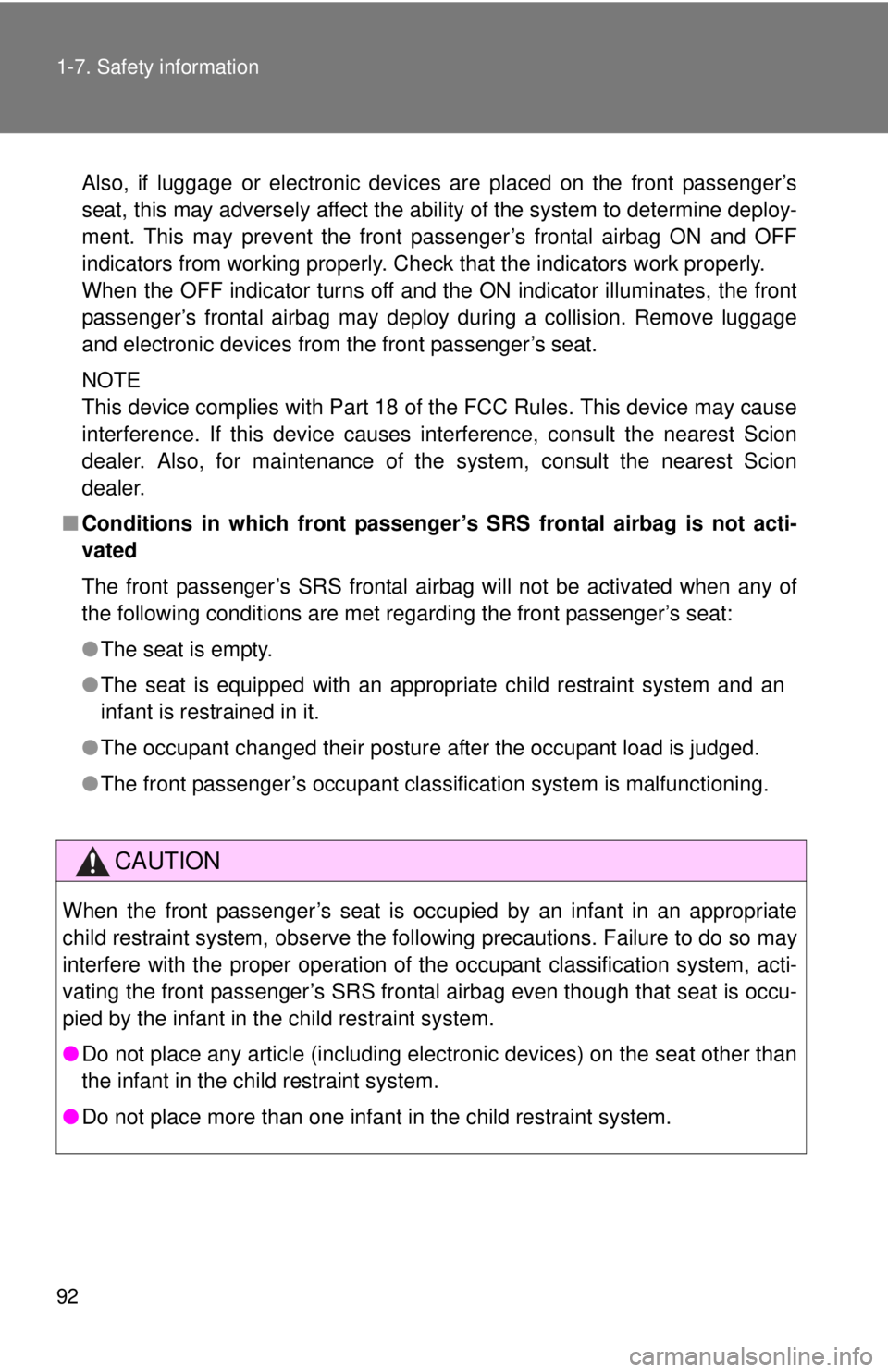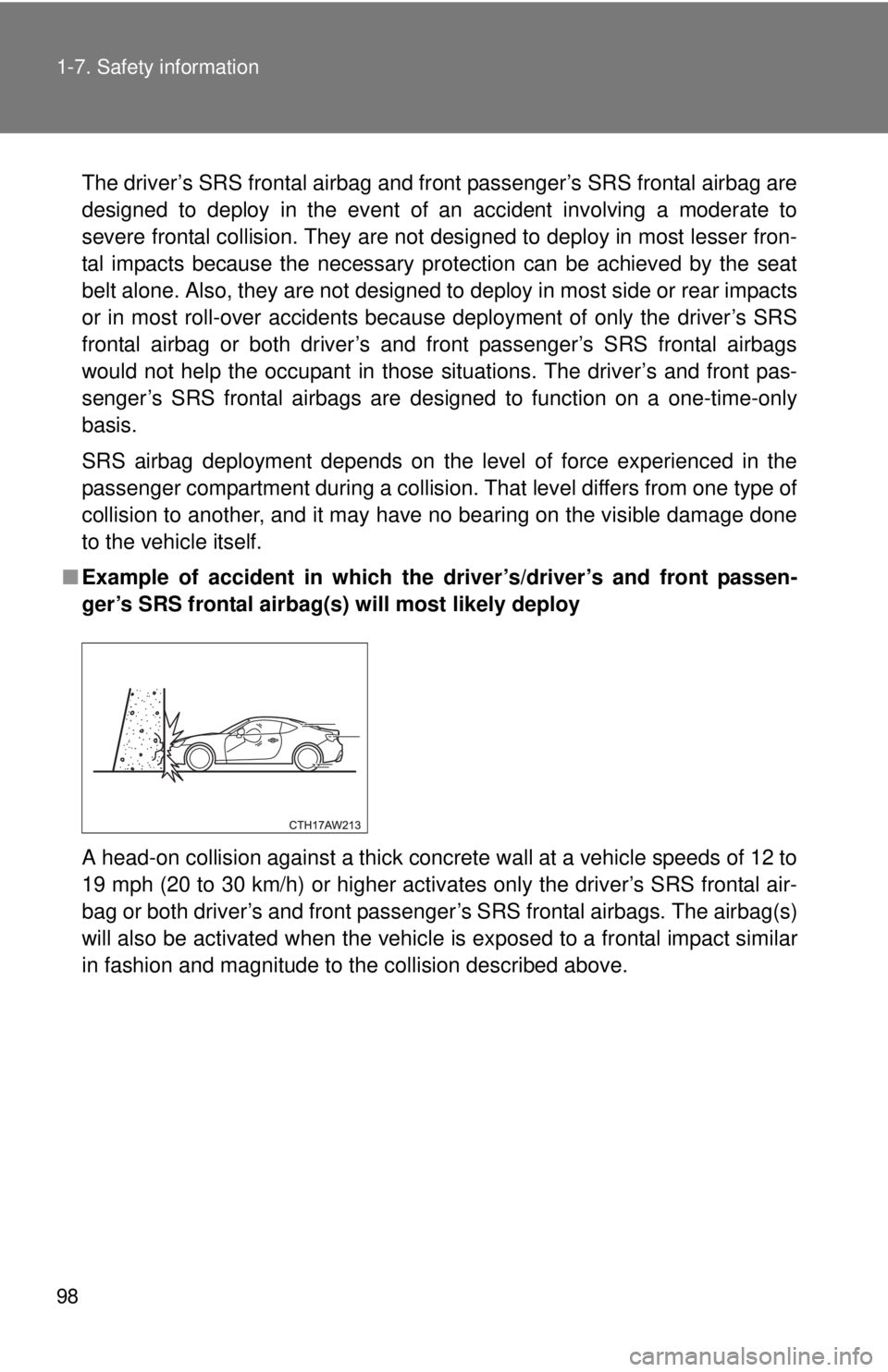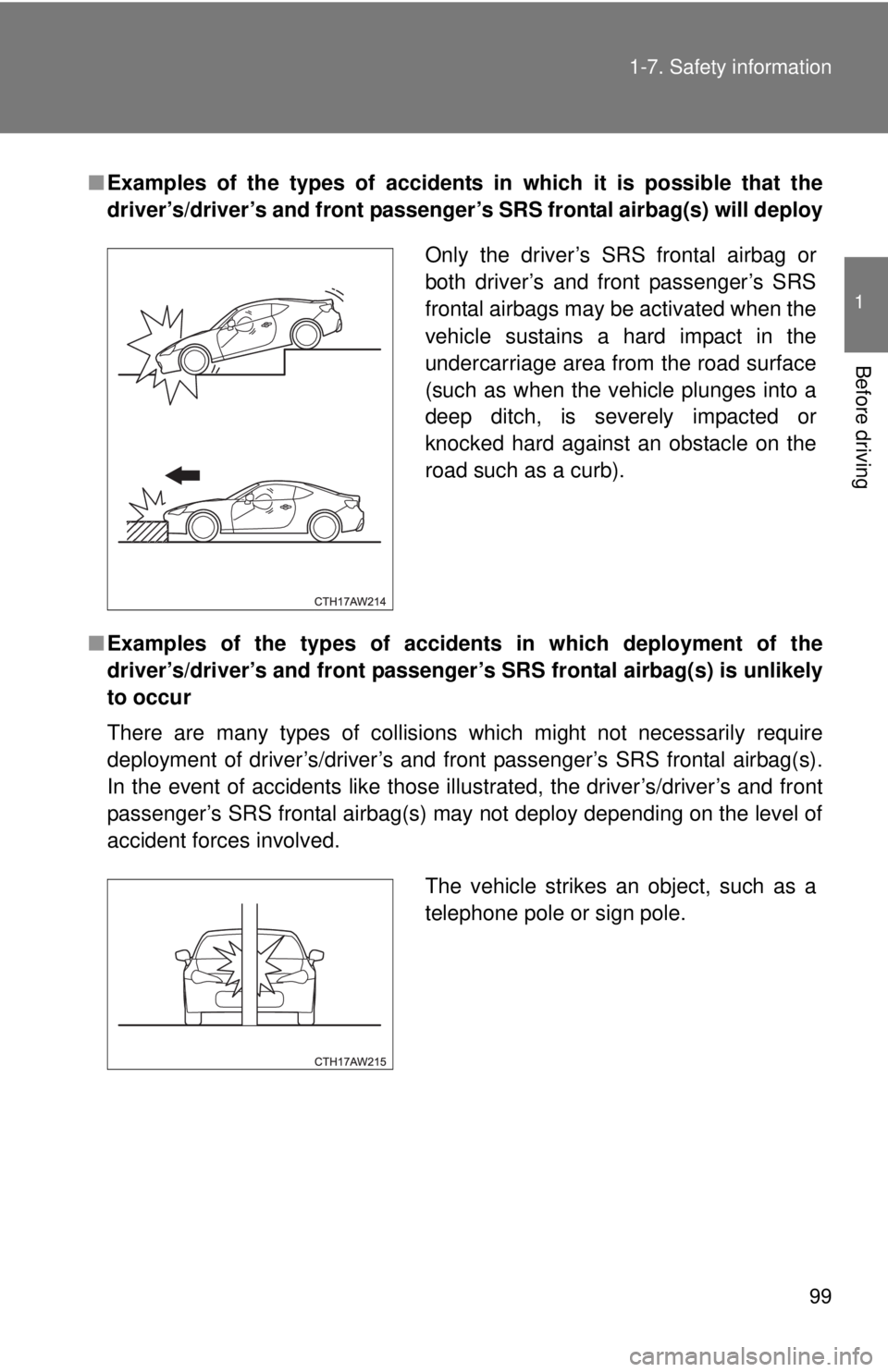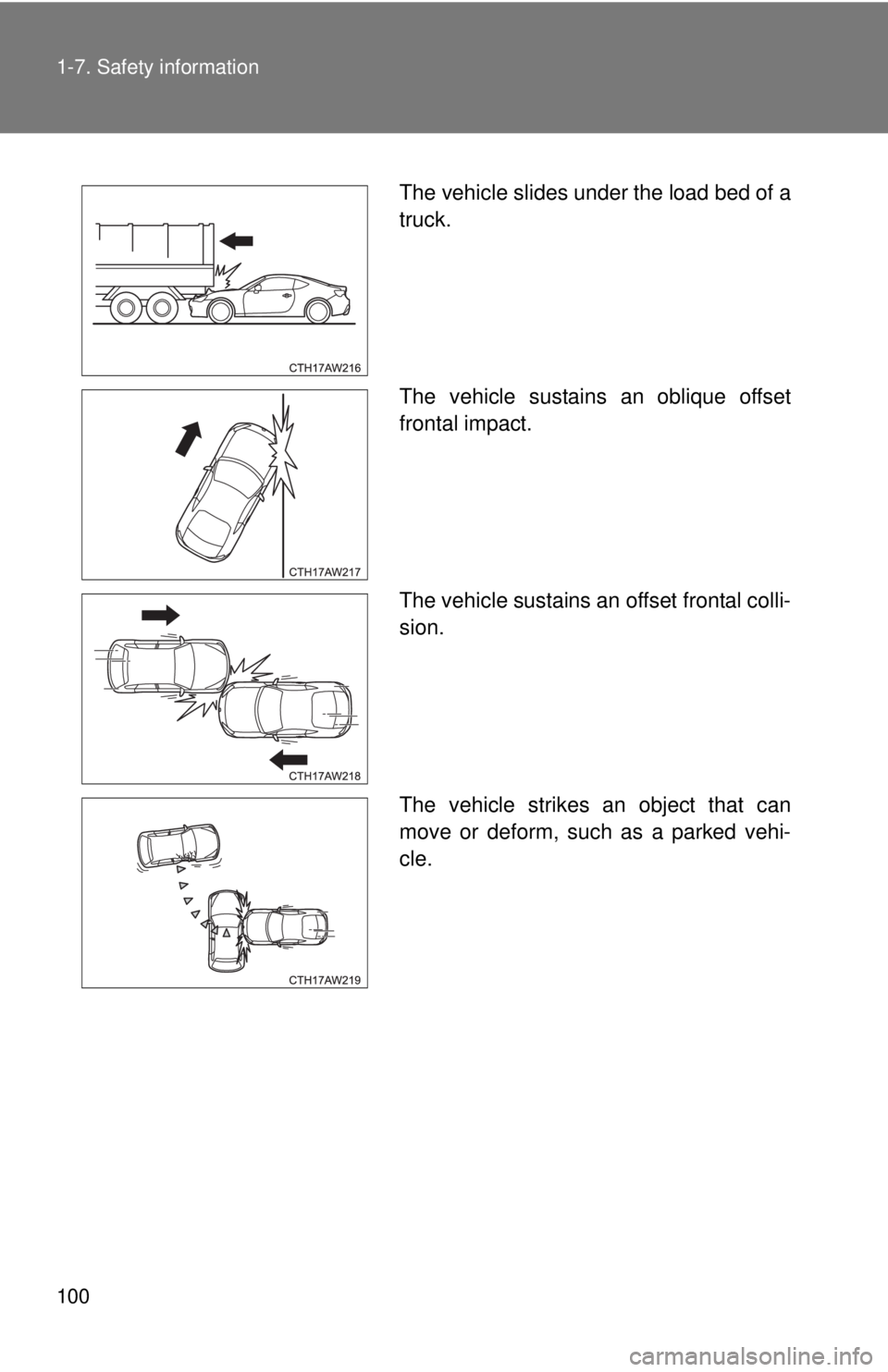TOYOTA FR-S 2015 Owners Manual (in English)
Manufacturer: TOYOTA, Model Year: 2015, Model line: FR-S, Model: TOYOTA FR-S 2015Pages: 452, PDF Size: 9.97 MB
Page 91 of 452

91 1-7. Safety information
1
Before driving
If the seat belt buckle switch and/or front passenger’s occupant classification
system have failed, the SRS warning light will illuminate. Have the system
inspected by your Scion dealer immediately if the SRS warning light illumi-
nates.
If your vehicle has sustained impact, this may affect the proper function of
the Scion advanced frontal airbag system. Have your vehicle inspected at
your Scion dealer. Do not use the front passenger’s seat while driving the
vehicle to your Scion dealer.
NOTE
The front passenger’s SRS side airbag and SRS curtain shield airbag are
not controlled by the Scion advanced frontal airbag system.
■Passenger’s frontal airbag ON and OFF indicators
P. 1 1 7
■Occupant classification system
The occupant classification system sensor is installed under the seat uphol-
stery and monitors the physique and posture of the front passenger. Using
this information, the occupant classification system determines whether the
front passenger’s SRS frontal airbag should be deployed or not.
If the front passenger’s seat cushion is wet, this may adversely affect the
ability of the system to determine deployment. If the seat cushion is wet, the
front passenger should stop sitting on the front passenger’s seat. Wipe off
liquid from the seat immediately, let the seat dry naturally and then check the
SRS warning light as follows.
●If the SRS warning light illuminates, keep the seat dry until the warning
light turns off. If the SRS warning light stays on even when the seat has
dried, do not allow anyone to sit on the front passenger’s seat and have
the system checked by your Scion dealer.
●If the SRS warning light does not illuminate, check that the front passen-
ger’s frontal airbag ON and OFF indicators work properly. If the indicators
do not work properly, do not allow anyone to sit on the front passenger’s
seat and have the system checked by your Scion dealer.
Page 92 of 452

92 1-7. Safety information
Also, if luggage or electronic devices are placed on the front passenger’s
seat, this may adversely affect the ability of the system to determine deploy-
ment. This may prevent the front passenger’s frontal airbag ON and OFF
indicators from working properly. Check that the indicators work properly.
When the OFF indicator turns off and the ON indicator illuminates, the front
passenger’s frontal airbag may deploy during a collision. Remove luggage
and electronic devices from the front passenger’s seat.
NOTE
This device complies with Part 18 of the FCC Rules. This device may cause
interference. If this device causes interference, consult the nearest Scion
dealer. Also, for maintenance of the system, consult the nearest Scion
dealer.
■Conditions in which front passenger’s SRS frontal airbag is not acti-
vated
The front passenger’s SRS frontal airbag will not be activated when any of
the following conditions are met regarding the front passenger’s seat:
●The seat is empty.
●The seat is equipped with an appropriate child restraint system and an
infant is restrained in it.
●The occupant changed their posture after the occupant load is judged.
●The front passenger’s occupant classification system is malfunctioning.
CAUTION
When the front passenger’s seat is occupied by an infant in an appropriate
child restraint system, observe the following precautions. Failure to do so may
interfere with the proper operation of the occupant classification system, acti-
vating the front passenger’s SRS frontal airbag even though that seat is occu-
pied by the infant in the child restraint system.
●Do not place any article (including electronic devices) on the seat other than
the infant in the child restraint system.
●Do not place more than one infant in the child restraint system.
Page 93 of 452

93 1-7. Safety information
1
Before driving
■If the front passenger’s frontal airbag ON indicator illuminates and the
OFF indicator turns off even when an infant or a small child is in a child
restraint system (including booster seat)
Turn the “ENGINE START STOP” switch off if the front passenger’s frontal
airbag ON indicator illuminates and the OFF indicator turns off even when an
infant or a small child is in a child restraint system (including booster seat).
Remove the child restraint system from the seat. By referring to the child
restraint manufacturer’s recommendations as well as the child restraint sys-
tem installation procedures in “Child restraint systems” (P. 125), correctly
install the child restraint system. Turn the “ENGINE START STOP” switch to
IGNITION ON mode and make sure that the front passenger’s frontal airbag
ON indicator turns off and the OFF indicator illuminates.
If still the ON indicator remains illuminated while the OFF indicator turns off,
take the following actions.
●Ensure that no article is placed on the seat other than the child restraint
system and the child occupant.
●Ensure that the backward-forward position and seatback of front passen-
ger’s seat are locked into place securely by moving the seat back and
forth.
If the ON indicator still remains illuminated while the OFF indicator turns off
after taking relevant corrective actions described above, relocate the child
restraint system to the rear seat and immediately contact your Scion dealer
for an inspection.
NOTE
When a child who has outgrown a child restraint system or a small adult is
seated in the front passenger’s seat, the Scion advanced frontal airbag sys-
tem may or may not activate the front passenger’s SRS frontal airbag
depending on the occupant’s seating posture. The child should always wear
the seat belt when sitting in the seat irrespective of whether the airbag is
deactivated or activated. If the front passenger’s SRS frontal airbag is acti-
vated (the ON indicator remains illuminated while the OFF indicator turns
off), take the following actions.
Page 94 of 452

94 1-7. Safety information
●Ensure that no article is placed on the seat other than the occupant.
If the ON indicator still remains illuminated while the OFF indicator turns off
despite the fact that the actions noted above have been taken, seat the
child/small adult in the rear seat and immediately contact your Scion dealer
for an inspection. Even if the system has passed the dealer inspection, it is
recommended that on subsequent trips the child/small adult always take the
rear seat.
Children who have outgrown a child restraint system should always wear the
seat belt irrespective of whether the airbag is deactivated or activated.
■Conditions in which front passenger’s SRS frontal airbag is activated
The front passenger’s SRS frontal airbag will be activated for deployment
upon impact when any of the following conditions are met regarding the front
passenger’s seat.
●When the seat is occupied by an adult.
●When a certain item(s) (e.g. jug of water) is placed on the seat.
Page 95 of 452

95 1-7. Safety information
1
Before driving
■If the passenger’s frontal airbag OFF indicator illuminates and the ON
indicator turns off even when the front passenger’s seat is occupied by
an adult
This can be caused by the adult incorrectly sitting in the front passenger’s
seat. Turn the “ENGINE START STOP” switch off. Ask the front passenger
to set the seatback to the upright position, sit up straight in the center of the
seat cushion, correctly fasten the seat belt, position his/her legs out forward,
and adjust the seat to the rearmost position. Turn the “ENGINE START
STOP” switch to IGNITION ON mode. If the OFF indicator remains illumi-
nated while the ON indicator remains off, take the following actions.
●Turn the “ENGINE START STOP” switch off.
●Make sure that the front passenger does not use a blanket, seat cushion,
seat cover, seat heater or massager, etc.
●If wearing excessive layers of clothing, the front passenger should
remove any unnecessary items before sitting in the front passenger’s
seat, or should sit in a rear seat.
●Next, turn the “ENGINE START STOP” switch to IGNITION ON mode
and wait 6 seconds to allow the system to complete self-checking. Fol-
lowing the system check, both indicators turn off for 2 seconds. Now, the
ON indicator should illuminate while the OFF indicator remains off.
If the OFF indicator still remains illuminated while the ON indicator remains
off, ask the occupant to move to the rear seat and immediately contact your
Scion dealer for an inspection.
Page 96 of 452

96 1-7. Safety information
■Operation
Driver's side
Passenger’s side
SRS AIRBAGs deploy as soon as a
collision occurs.
After deployment, SRS AIRBAGs start
to deflate immediately so that the
driver’s vision is not obstructed.
SRS AIRBAGs deploy as soon as a
collision occurs.
After deployment, SRS AIRBAGs start
to deflate immediately so that the
driver's vision is not obstructed.
Page 97 of 452

97 1-7. Safety information
1
Before driving
The SRS airbag can function only when the “ENGINE START STOP” switch
is in IGNITION ON mode.
The Scion advanced frontal airbag system is designed to determine the acti-
vation or deactivation condition of the front passenger’s SRS frontal airbag
depending on the characteristic of the item(s) or person on the front passen-
ger’s seat monitored by the front passenger’s occupant classification system
sensor. For this reason, only the driver’s SRS frontal airbag may deploy in
the event of a collision, but this does not mean failure of the system.
If the front sub sensors and the impact sensors in the airbag control module
detect a predetermined amount of force during a frontal collision, the control
module sends signals to the airbag module(s) (only driver’s module or both
driver’s and front passenger’s modules) instructing the module(s) to inflate
the SRS frontal airbag(s).
The driver’s and front passenger’s SRS frontal airbags use dual stage infla-
tors. The two inflators of each airbag are triggered either sequentially or
simultaneously, depending on the severity of impact, in the case of the
driver’s SRS frontal airbag and depending on the severity of impact and the
characteristic of the item(s) or person on the seat in the case of the front
passenger’s SRS frontal airbag.
After deployment, the SRS airbag immediately starts to deflate so that the
driver’s vision is not obstructed. The time required from detecting impact to
the deflation of the SRS airbag after deployment is shorter than the blink of
an eye.
Both when only the driver’s SRS frontal airbag deploys and the driver’s and
front passenger’s SRS frontal airbags deploy, the driver’s and front passen-
ger’s seat belt pretensioners operate at the same time.
Although it is highly unlikely that the SRS airbag would activate in a non-
accident situation, should it occur, the SRS airbag will deflate quickly, not
obscuring vision and will not interfere with the driver's ability to maintain con-
trol of the vehicle.
When the SRS airbag deploys, a sudden, fairly loud inflation noise will be
heard and some smoke will be released. These occurrences are a normal
result of the deployment. This smoke does not indicate a fire in the vehicle.
Page 98 of 452

98 1-7. Safety information
The driver’s SRS frontal airbag and front passenger’s SRS frontal airbag are
designed to deploy in the event of an accident involving a moderate to
severe frontal collision. They are not designed to deploy in most lesser fron-
tal impacts because the necessary protection can be achieved by the seat
belt alone. Also, they are not designed to deploy in most side or rear impacts
or in most roll-over accidents because deployment of only the driver’s SRS
frontal airbag or both driver’s and front passenger’s SRS frontal airbags
would not help the occupant in those situations. The driver’s and front pas-
senger’s SRS frontal airbags are designed to function on a one-time-only
basis.
SRS airbag deployment depends on the level of force experienced in the
passenger compartment during a collision. That level differs from one type of
collision to another, and it may have no bearing on the visible damage done
to the vehicle itself.
■Example of accident in which the driver’s/driver’s and front passen-
ger’s SRS frontal airbag(s) will most likely deploy
A head-on collision against a thick concrete wall at a vehicle speeds of 12 to
19 mph (20 to 30 km/h) or higher activates only the driver’s SRS frontal air-
bag or both driver’s and front passenger’s SRS frontal airbags. The airbag(s)
will also be activated when the vehicle is exposed to a frontal impact similar
in fashion and magnitude to the collision described above.
Page 99 of 452

99 1-7. Safety information
1
Before driving
■Examples of the types of accidents in which it is possible that the
driver’s/driver’s and front passenger’s SRS frontal airbag(s) will deploy
■Examples of the types of accidents in which deployment of the
driver’s/driver’s and front passenger’s SRS frontal airbag(s) is unlikely
to occur
There are many types of collisions which might not necessarily require
deployment of driver’s/driver’s and front passenger’s SRS frontal airbag(s).
In the event of accidents like those illustrated, the driver’s/driver’s and front
passenger’s SRS frontal airbag(s) may not deploy depending on the level of
accident forces involved.
Only the driver’s SRS frontal airbag or
both driver’s and front passenger’s SRS
frontal airbags may be activated when the
vehicle sustains a hard impact in the
undercarriage area from the road surface
(such as when the vehicle plunges into a
deep ditch, is severely impacted or
knocked hard against an obstacle on the
road such as a curb).
The vehicle strikes an object, such as a
telephone pole or sign pole.
Page 100 of 452

100 1-7. Safety information
The vehicle slides under the load bed of a
truck.
The vehicle sustains an oblique offset
frontal impact.
The vehicle sustains an offset frontal colli-
sion.
The vehicle strikes an object that can
move or deform, such as a parked vehi-
cle.